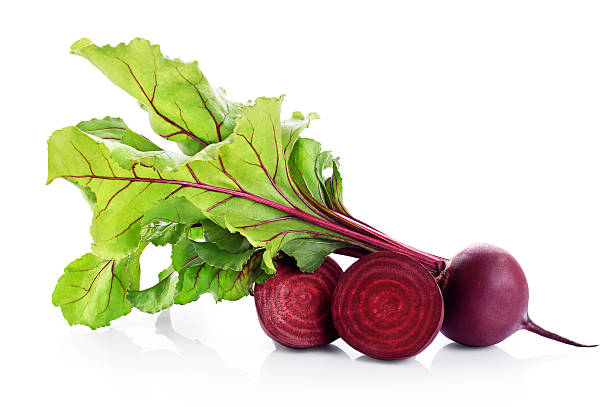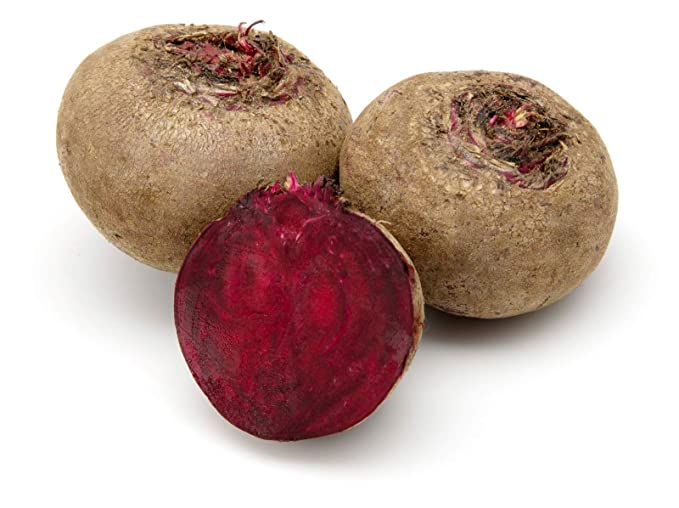

Beta vulgaris L.
|
Beet is commonly known as Chukander and belongs to the family Chenopodiaceae. It has napiform red root-stock which is cultivated and eaten cooked or raw. Beets are rich in vitamin B9 (Folate) that helps cells growth and function and in controlling damage to blood vessels reducing the risk of any heart disease. Betalains present in beets are shown to reduce the protein levels of the proinflammatory cytokines TNF-α, IL-6, IL-8, and IL-1β, the reactive oxygen and nitrogen species levels. Mode of Consumption : Fresh, fried, boiled and raw as salad |
| Plant Details | Agro-climatic Zone | Vernacular Names | Pictures |
| Scientific Name: Beta vulgaris L. Family: Amaranthaceae Juss. Class: Magnoliopsida Order: Caryophyllales Genus: Beta L. Fruiting Season: April to May Parts: Tender leaves & Root |
|
Andhra Pradesh : Beet root Assam : Beet Bihar : Beet, Chukandar, Chukkndan, Mithe Cuqandara Himachal Pradesh : Chukandar Karnataka : Beet root Tamil Nadu : Carkkaraivallikkilanku Uttar Pradesh : Chukandar, Beet West Bengal : Beet root |
 Root  Tuber |
| Compound/Extract | Activity | Mode of Action | Marker/References |
| Phenolic amides | Anti-inflammatory | Phenolic amides showed inhibitory effects on nitric oxide production in a dose-dependent manner in macrophages with IC50 values of 18.7 µm. | [1] |
| Betalain | Anti-inflammatory | Betalain (100 mg/kg) inhibited superoxide anion and pro-inflammatory cytokines (TNF-α and IL-1β) production, and increased antiinflammatory (IL-10) cytokine release. | TNF-α, IL-1β, and IL-10[3] |
| Betalain | Anticancer | Betalains (mixture of Vitexin-2-O-xyloside + Betaxanthin + Betacyanin) reduced cyclooxygenase-2 (COX-2) and IL-8 mRNA expression after lipopolysaccharide induction in Caucasian colon adenocarcinoma (CaCo-2). | COX-2 and IL-8[7] |
| Red beet juice | Anti-inflammatory | Clinical trial showed that 24 hypertensive subjects who consumed 250 mL/day of red beet juice or 250 g/day of cooked beet for 2 weeks, the levels of proinflammatory markers, like IL-6 and TNF-α, were significantly decreased. | IL-6 and TNF-α[9] |
| Ethanolic extract | Anti-inflammatory | Ethanolic extract (250 and 500 mg/kg) treatment along with Gentamicin (GM) significantly downregulates the renal nuclear protein expression of NF-κB and NF-κB-DNA binding activities as well as proinflammatory cytokines (TNF-α and IL-6) in dose dependent manner as compared to only GM treated rats. | NF-κB, TNF-α, and IL-6[10] |
| Betalain | Anti-inflammatory | Betalains present in beets are shown to reduce the protein levels of the proinflammatory cytokines TNF-α, IL-6, IL-8, and IL-1β, the reactive oxygen and nitrogen species levels. | TNF-α, IL-6, IL-8, and IL-1β[12] |
| Betanin | Anticancer | Oral ingestion of betanin in ICR mice inhibited tumor promoter 12-O-tetradecanoylphorbol- I3-acetate (TPA) induced promotion of mice skin tumors. | TPA[5] |
| Beet root extract | Antioxidant, Immunomodulatory | Beet root extract attenuates the Caspase-3 immunoreactivity and reduces oxidative stress through their ROS-scavenging properties. | Caspase-3 and ROS[11] |
| Beet root extract | Antioxidant | The levels of MDA was decreased whereas the levels of GSH and total Antioxidant capacity increases after the feeding of beet root extract. | MDA and GSH[11] |
| Beet root extract | Anti-inflammatory | IL-6 cytokine was significantely decreased in the Cisplatin (Cis) induced rats after feeding beet root extract. | IL-6[11] |
| Major Class | Metabolites (Content of bioactives: mg/100g Fresh Weight) |
| Alkaloid | Isobetanidin: 4.6 mg/100 g DM, Isobetanin: 71.3 mg/100g DM, Neobetanin: , N-transferuloyl 3-O-methyldopamine: , Prebetanin: [8] |
| Betalain | Betacyanin: 40-210, Betanidin: 18.2 mg/100 g DM, Betanin: 312.5 mg/100 g DM, Vulgaxanthin-I: 104.1 mg/100 g DM, Vulgaxanthin-II: 57.4 mg/100 g DM[8] |
| Carboxylic Acid | Caffeic acid: 3.7 mg/100 g (cv. Detroit Dark Red ), Chlorogenic acid: 1.8 mg/100g (cv. Detroit Dark Red ), Ferulic acid: 132.52 mg/100g DW, n-cis-Feruloyltyramine: , N-trans-feruloyl tyramine: , p-coumaric acid: var. cicla, p-Hydroxybenzoic acid: 1.13 mg/100g DW, Proline: var. cicla, Protocatechuic acid: 5.42 mg/100g DW, Syringic acid: , Vanillic acid: 5.12 mg/100g DW[8] |
| Ether | Dihydroisorhamnetin: [8] |
| Flavonoid | Betagarin: , Betavulgarin: , Cochliophilin A: , Isovitexin: , Kaempferol: 9.2 mg/100g, Quercetin : 7.5 mg/100g, Rutin: 0.25 mg/100g DW, Vitexin: , Vitexin-2-O-rhamnoside: , Vitexin-2-O-xyloside: [7] |
| Flavonol | Catechin: 37.96 mg/100g DW, Catechin hydrate: 4.7 mg/100g (cv. Detroit Dark Red )[8] |
| Heterocyclic Compound | Epicatechin: 3.2 mg/100g (cv. Detroit Dark Red )[8] |
| Phenol | 4-Hydroxybenzoic acid: 1.2 mg/100g (cv. Detroit Dark Red )[8] |
| Pyridine | Betaxanthin: 20-140[6] |
| Terpenoid | β- Carotene: [8] |
| Triterpenoid | Monoterpene dehydrovomifoliol: var. cicla[8] |
| Effect | Observation | DOI |
| Animal model studies | Increase in Lactobacillus and Enterococcus population | DOI: 10.1016/j.etp.2010.12.001 |
| In vitro studies | Increase in Bacteroidetes and Firmicutes | DOI: 10.1016/j.procbio.2011.01.013 |
| Disease | Formulation | Reference | Author | TKDL |
| Information from Wealth of India | Reference |
|
CSIR(1950).The Wealth of India, Raw materials,Vol.-II ,P.183-184, New Delhi, India |
| 4.2, 04.2.1, 04.2.1.1, 04.2.1.3, 04.2.2.3, 04.2.2.5, 04.2.2.6, 04.2.2.8 |
| CSIR-North East Institute of Science and Technology, Jorhat-6, Assam, India
CSIR-Institute of Himalayan Bioresource Technology, Palampur-61,Himachal Pradesh, India |